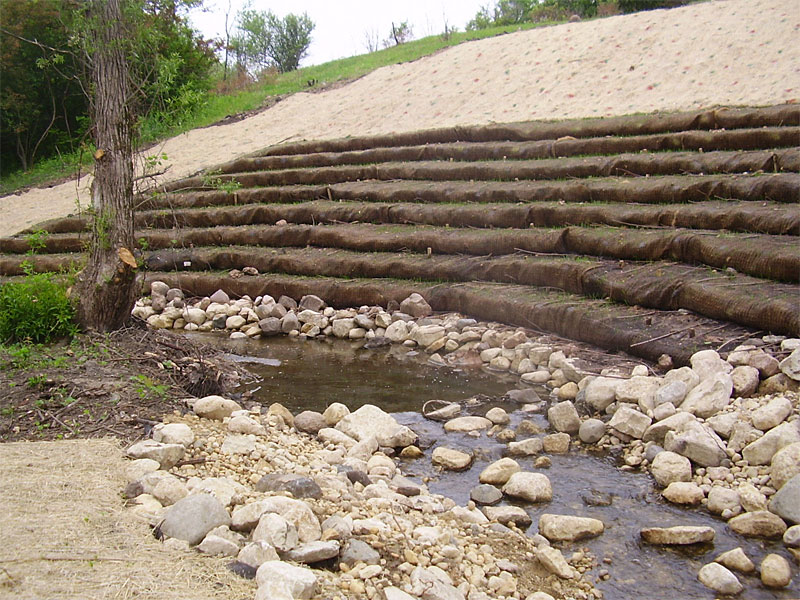Vegetated Geogrids

Alternating layers of live branch cuttings and compacted soil with geotextiles wrapped around each soil lift.
Image credit: Almeda County Resource Conservation District
Description
A vegetated geogrid or geotextile consists of alternating layers of live branch cut tings and compacted soil with geotextiles (natural or synthetic) wrapped around each soil lift. The system is sometimes also referred to as "fabric encapsulated soil" or "live soft gabion. " The geogrid traps sediment and reinforces and rebuilds the streambank.
Applicability
Alternating layers of live branch cuttings and compacted soil with geotextiles wrapped around each soil lift (Image credit: Almeda County Resource Conservation District)
Vegetated geogrids can be used to quickly establish riparian vegetation if they are properly designed and installed. They can enhance conditions for colonization of native vegetation. They are applicable on steeper and higher slopes than brush layering, and can tolerate higher initial flow velocities. They can be helpful for restoring outside bends where erosion is a problem.
Effectiveness
The effectiveness of a geogrid will increase with time, as vegetation becomes permanently established. The use of live woody vegetation provides erosion control, habitat and aesthetic value, while the incorporation of synthetic materials increases stability.
Costs
Material costs range from approximately $13-30 per linear foot. This does not include the cost of installation, and this technique requires both heavy equipment and intensive manual labor to install. Installation of a geogrid on 123 ft of a California riverbank required approximately 120 man-hours (Fischenich et al. 2001).
Operation and Maintenance
The geogrid should be regularly monitored and repaired as necessary. In particular, it should be inspected for the formation of gullies beneath the mattress prior to the establishment of the root system. Once vegetation is established, maintenance costs are reduced considerably (Fischenich et al 2001).
Design Considerations
Systems over 7 feet in height and 20 feet in length should have an engineering analysis for slope stability. This technique requires both heavy equipment and intensive manual labor to install.
Used above and below stream-forming flow conditions. Drainage areas should be generally less than 2,000 acres with stable streambeds. The system must be built during low flow conditions. Stream banks are wetland resource areas as protected under the Massachusetts Wetlands Protection Act. As such, permitting will be required.
References
Beidenharn, D. S. , C. M. Elliott and C. C. Watson. 1997. The WES stream investigation and streambank stabilization handbook. Prepared for the US Environmental Protection Agency by US Army Corps of Engineers Water ways Experiment Station, Vicksburg, MS.
http://www.engr.colostate.edu/~cwatson/ce_old/
Fischenich, C. , H. H. Allen and D. N. McComas. 2001. Plant Material Aquisition, Layout and Handling for Flood Control Projects. Engineer Research and Development Center, Flood Damage Reduction and Research Center, Vicksburg, MS.
http://www.wes.army.mil/
FISRWG. 1998. Stream Corridor Restoration: Principles, Processes, and Practices. Federal Interagency Stream Restoration Working Group,
http://www.usda.gov/wps/portal/usdahome
IDNR. 1996 (Revised 1999). Indiana Drainage Handbook . Indiana Department of Natural Resources, Office of Water, Indianapolis, Indiana.
http://www.state.in.us/dnr/water
LCSMC. Lake County Stormwater Management Commission (LCSMC), Lake County Planning, Building and Development Department, U. S. D. A. Natural Resources Conservation Service. 2002. Streambank and Shoreline Protection Manual.
http://www.usace.army.mil/
Miller, D. E. 1992. Bio-engineered stream channel used to restore New Jersey brook. Land and Water. July/Au gust 12-14. "Natural Reinforcement. " International Society for Soil Mechanics and Geotechnical Engineering. Accessed 7/16/02.
http://tc17.poly.edu/natural.html
Sotir, R. B. 1999. Slope Stabilization and Restoration. Erosion Control. 6 (1):46-54.